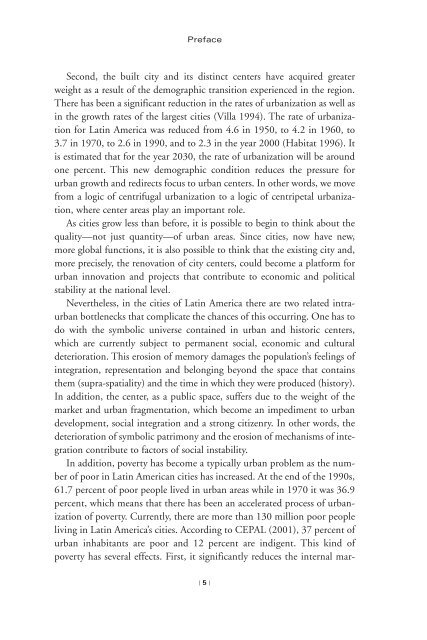urban regeneration and revitalization in the americas - Woodrow ...
urban regeneration and revitalization in the americas - Woodrow ...
urban regeneration and revitalization in the americas - Woodrow ...
You also want an ePaper? Increase the reach of your titles
YUMPU automatically turns print PDFs into web optimized ePapers that Google loves.
Preface<br />
Second, <strong>the</strong> built city <strong>and</strong> its dist<strong>in</strong>ct centers have acquired greater<br />
weight as a result of <strong>the</strong> demographic transition experienced <strong>in</strong> <strong>the</strong> region.<br />
There has been a significant reduction <strong>in</strong> <strong>the</strong> rates of <strong>urban</strong>ization as well as<br />
<strong>in</strong> <strong>the</strong> growth rates of <strong>the</strong> largest cities (Villa 1994). The rate of <strong>urban</strong>ization<br />
for Lat<strong>in</strong> America was reduced from 4.6 <strong>in</strong> 1950, to 4.2 <strong>in</strong> 1960, to<br />
3.7 <strong>in</strong> 1970, to 2.6 <strong>in</strong> 1990, <strong>and</strong> to 2.3 <strong>in</strong> <strong>the</strong> year 2000 (Habitat 1996). It<br />
is estimated that for <strong>the</strong> year 2030, <strong>the</strong> rate of <strong>urban</strong>ization will be around<br />
one percent. This new demographic condition reduces <strong>the</strong> pressure for<br />
<strong>urban</strong> growth <strong>and</strong> redirects focus to <strong>urban</strong> centers. In o<strong>the</strong>r words, we move<br />
from a logic of centrifugal <strong>urban</strong>ization to a logic of centripetal <strong>urban</strong>ization,<br />
where center areas play an important role.<br />
As cities grow less than before, it is possible to beg<strong>in</strong> to th<strong>in</strong>k about <strong>the</strong><br />
quality—not just quantity—of <strong>urban</strong> areas. S<strong>in</strong>ce cities, now have new,<br />
more global functions, it is also possible to th<strong>in</strong>k that <strong>the</strong> exist<strong>in</strong>g city <strong>and</strong>,<br />
more precisely, <strong>the</strong> renovation of city centers, could become a platform for<br />
<strong>urban</strong> <strong>in</strong>novation <strong>and</strong> projects that contribute to economic <strong>and</strong> political<br />
stability at <strong>the</strong> national level.<br />
Never<strong>the</strong>less, <strong>in</strong> <strong>the</strong> cities of Lat<strong>in</strong> America <strong>the</strong>re are two related <strong>in</strong>tra<strong>urban</strong><br />
bottlenecks that complicate <strong>the</strong> chances of this occurr<strong>in</strong>g. One has to<br />
do with <strong>the</strong> symbolic universe conta<strong>in</strong>ed <strong>in</strong> <strong>urban</strong> <strong>and</strong> historic centers,<br />
which are currently subject to permanent social, economic <strong>and</strong> cultural<br />
deterioration. This erosion of memory damages <strong>the</strong> population’s feel<strong>in</strong>gs of<br />
<strong>in</strong>tegration, representation <strong>and</strong> belong<strong>in</strong>g beyond <strong>the</strong> space that conta<strong>in</strong>s<br />
<strong>the</strong>m (supra-spatiality) <strong>and</strong> <strong>the</strong> time <strong>in</strong> which <strong>the</strong>y were produced (history).<br />
In addition, <strong>the</strong> center, as a public space, suffers due to <strong>the</strong> weight of <strong>the</strong><br />
market <strong>and</strong> <strong>urban</strong> fragmentation, which become an impediment to <strong>urban</strong><br />
development, social <strong>in</strong>tegration <strong>and</strong> a strong citizenry. In o<strong>the</strong>r words, <strong>the</strong><br />
deterioration of symbolic patrimony <strong>and</strong> <strong>the</strong> erosion of mechanisms of <strong>in</strong>tegration<br />
contribute to factors of social <strong>in</strong>stability.<br />
In addition, poverty has become a typically <strong>urban</strong> problem as <strong>the</strong> number<br />
of poor <strong>in</strong> Lat<strong>in</strong> American cities has <strong>in</strong>creased. At <strong>the</strong> end of <strong>the</strong> 1990s,<br />
61.7 percent of poor people lived <strong>in</strong> <strong>urban</strong> areas while <strong>in</strong> 1970 it was 36.9<br />
percent, which means that <strong>the</strong>re has been an accelerated process of <strong>urban</strong>ization<br />
of poverty. Currently, <strong>the</strong>re are more than 130 million poor people<br />
liv<strong>in</strong>g <strong>in</strong> Lat<strong>in</strong> America’s cities. Accord<strong>in</strong>g to CEPAL (2001), 37 percent of<br />
<strong>urban</strong> <strong>in</strong>habitants are poor <strong>and</strong> 12 percent are <strong>in</strong>digent. This k<strong>in</strong>d of<br />
poverty has several effects. First, it significantly reduces <strong>the</strong> <strong>in</strong>ternal mar-<br />
| 5 |

















